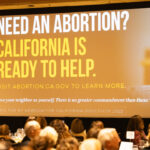(Image source: Illustration by Texas Monthly; MAGA logo: Mark Wilson, Getty; hat: Getty)
A few days after the 2004 election, a group of gay Republicans recommitted themselves to their work of reaching out to people of faith across the country.
Many of them were believers themselves, and they bristled at how they felt a handful of fire-breathing fundamentalists had hijacked the Christian faith and the Republican Party. They were angry with how evangelical preachers and televangelist tyrants selectively used Scripture to misguide millions of Americans with harmful views of homosexuality that shaped their resistance to gay rights. But rather than vilifying or shaming them as bigots, these gay Republicans believed they needed to build bridges of connection through gentle messaging, factual information, and patient understanding. That strategy mirrored the way many of them had handled their own conservative friends and families when they had come out to them, and they felt it provided a blueprint for the nation. Through “one person at a time,” the gay Republicans’ planning document insisted, “education can create equality.”
Given the recent election results, that plan might have struck many as hopelessly naive. Voters in thirteen states had just overwhelmingly endorsed ballot initiatives to add amendments to their state constitutions that banned same-sex marriage. Many political observers believed Republican Party strategists had cynically worked to get the initiatives onto the ballots in order to boost white evangelical turnout in key battleground states and, thus, ensure George W. Bush’s re-election.
Election analysis would later show Bush probably hadn’t needed the gay marriage bans to bring about his win – it is generally hard to unseat an incumbent wartime president, after all – but the mobilization of voters through religious networks, especially evangelical churches, for the anti-gay-marriage laws seemed to provide yet the latest evidence of the increasingly tight bond between conservative religious voters and the GOP.
Homosexuality, perhaps more than any other issue, including abortion, had helped forge that connection. In the early 1990s, when a different Bush was in the White House and fears of HIV/AIDS had reinvigorated the worst moral condemnations of homosexuality, Reverend Lou Sheldon of the Traditional Values Coalition explained the motivation to a reporter. Homosexuality “galvanizes our public more than right-to-life,” he said. “It is absolutely a vital issue to Bible-believing Christians.” Believing that homosexuality constituted an individual moral failure and an existential threat to the basic building block of society – that is, the patriarchal, monogamous heterosexual family unit – these Christian conservatives contended that granting basic rights to gay Americans would not only help legitimize homosexuality but also draw more people into it. Since, as they believed, homosexuality was a choice, then granting legal rights to gay people and increasing the cultural acceptance of homosexuality would work to encourage more people, especially impressionable children, into the deviant “gay lifestyle.”
And with the emergence of a small but growing movement for same-sex marriage rights in the late 1990s and early 2000s – one made real by significant legal developments in Hawaii and Massachusetts – religious right leaders and evangelical pastors warned their followers that liberal activists were trying to dramatically transform American society by “redefining” marriage. “It is hard to imagine a more radical concept than extending marriage to same sexes,” the Family Research Council’s Gary Bauer argued.
Yet the support for state constitutional amendments banning same-sex marriage showed that religious right-wingers weren’t the only ones who opposed granting a basic civil right to LGBTQ Americans. In twelve of the thirteen states where the initiatives were on the ballots, more people had endorsed the anti-gay-marriage proposals than had voted to re-elect Bush.
That support wasn’t unexpected given the polling around same-sex marriage. Through the previous decade, consistently less than a third of Americans said same-sex marriage should be legalized – and those numbers had barely budged by 2004.
At the same time, there were other poll numbers that gave the leaders of Log Cabin Republicans (LCR), the nation’s oldest and largest gay Republican organization with nearly 20,000 members by the mid-2000s, a glimmer of hope – and an idea. A survey taken near the time of the election had found that one’s position on same-sex marriage highly correlated with beliefs about the nature of sexual orientation. Among those Americans who thought sexual orientation was an in-born trait, 79 percent indicated their support for same-sex marriage. On the other hand, only 22 percent of Americans who believed that sexuality was a matter of “choice” said same-sex marriage should be made legal.

(Image source: Log Cabin Republicans of D.C.)
Gay Republicans viewed this disparity – nearly sixty percent – as an opportunity. The key to improving public attitudes about homosexuality and winning essential rights, especially marriage, they contended, could be accomplished by simply getting more Americans to understand that homosexuality had a biogenetic basis. Rather than arguing that LGBTQ persons had a Constitutional right to same-sex marriage, these gay Republicans dedicated themselves to reaching out and educating those who held negative opinions about homosexuality.
Through its sister organization, the Liberty Education Forum (LEF), Log Cabin Republicans in the mid-2000s launched its “Reaching the Heartland” program, a multi-pronged strategy aimed at areas of the country that showed the lowest support for homosexuality and gay rights. These gay Republicans felt that liberal activists had been successful in making both of the nation’s coasts “gay friendly.” Now, however, enough people in the Midwest, South, and Mountain West had to be persuaded to change their minds about homosexuality if gay rights, especially marriage, were to achieve sufficient support. Gay Republicans thought these were the areas of the country where they could be particularly effective. “Our challenge now is clear. We must move beyond the traditional gay meccas to conservative middle America,” a strategy document outlined. “Achieving full equality for gay and lesbian Americans depends on having more support for fairness among conservative voters and people of faith,” another planning memo maintained.
Building on the work they had begun in the previous decade, gay Republicans developed materials and sponsored programs specifically tailored to Christian audiences. Such efforts revealed gay Republicans’ abiding faith that reason and facts could be used to convince decent Americans to make the right political decisions, including on gay rights.
***
When small handfuls of out gay men started forming the first gay Republican clubs in the late 1970s, creating a loose network of grassroots groups that would ultimately coalesce into the national Log Cabin Republicans organization in the early 1990s, they were not a particularly religious lot. Even if one of the clubs in San Francisco had been founded by a former Pentecostal minister, and the San Diego group was led by a devout Catholic and former altar boy, the bulk of the membership tended to lean more libertarian – and often libertine – in their politics, philosophies, and personal proclivities.
When it came to religion in politics, these white gay Republican men (who overwhelmingly dominated the organization to the near total exclusion of lesbians and persons of color) wanted to stop what they saw as the attempt by religious extremists to impose their moral beliefs on the public square. The first gay Republican clubs had been formed in California to prevent the passage of Proposition 6, a 1978 state ballot initiative that would have made it illegal for any gay or lesbian person to work in the state’s public school system. John Briggs, a California state legislator from Orange County, had authored the proposal, which came to be popularly known as the Briggs Initiative. Briggs, a Catholic, worked closely with Southern Baptist and fundamentalist churches to build support for his proposal just as religious conservatives in California – and across the nation – were beginning to organize to gain control of the Republican Party.
The Log Cabin clubs set about to defeat the Briggs Initiative and to thwart the takeover of the GOP by religious conservatives. They would succeed at the former, but were outmatched when it came to stopping the Republican Party from becoming the home of the religious right, even if polls consistently showed more than a million LGBTQ persons belonging to the GOP and far more LGBTQ Americans – sometimes fifty percent – regularly voting for Republican candidates in any given election. But as religious conservatives, particularly white evangelicals along with conservative Catholics, became the base of the GOP and captured control of the party’s infrastructure in the 1980s and 1990s, gay Republicans adjusted their approach to dealing with their fellow Republicans. While they still regularly attacked prominent religious right figureheads like Jerry Falwell and Pat Robertson as hateful demagogues, they made sure not to demonize churchgoing conservatives as intolerant bigots, as they felt the secular left typically characterized them.
This decision reflected gay Republicans’ general conservatism, part of the movement’s rightward shift in the 1990s. The HIV/AIDS crisis had been devastating for the Log Cabin clubs, killing a large portion of the original founders and members. The younger gay men who replaced them typically had grown up in Reagan-loving Republican families and retained more of their parents’ political and religious beliefs. Rather than seeing religious conservatives as strange interlopers in the Republican Party, as the gay Republicans of the 1970s and 1980s had, this new generation recognized them as their friends and family – the backbone of the party they loved. And these gay Republicans of the 1990s understood that beyond the religious right – and even the GOP – a broad swath of Americans held deep attachments to their religious faith. Working within rather than against this religiosity, gay Republicans believed, was essential to advancing LGBTQ equality, and such efforts required compassion and understanding, recognizing that many Americans had been misled by religious leaders they trusted. “Too often,” a “Reaching the Heartland” planning document argued, “negative views about gay people are based on ignorance, not anti-gay animus.”
Rich Tafel, Log Cabin’s president in the 1990s, was especially well positioned to present a different religious understanding of homosexuality. Raised in a devout Christian family in Pennsylvania, Tafel attended Harvard Divinity School, a time during which he came out as gay, and was ordained in the American Baptist Church. After briefly serving in the ministry, Tafel turned to politics, joining Republican Governor William Weld’s administration in Massachusetts before being tapped to run Log Cabin Republicans.
On political talk shows, Tafel regularly squared off against anti-gay religious leaders who he accused of selectively quoting Scripture out of context in order to condemn homosexuality. “I’m a Republican like you. I’m a Baptist like you,” Tafel said to Jerry Falwell on Larry King Live in 1992. “I wish you would stop assuming that you speak for all Christians when you say that, ‘as a Christian,’ it is wrong to be gay.”
Falwell responded that, unlike Tafel, he was a Christian who took the Bible literally. But Tafel wouldn’t budge. “No, you don’t,” he shot back. “Should slaves obey their masters? Should slaves obey their masters,” Tafel demanded Falwell answer about one of the Bible’s literal commands.
Tafel’s media appearances made it clear to the Log Cabin organization just how many Americans – both gay and straight – were looking for a different understanding of homosexuality than the loudest religious voices of homophobia were providing. Letters poured in from gay men and women who felt they’d had to abandon their religious faith upon coming out, and from parents who felt ill-equipped to defend their gay children at church and in their communities.

(Rich Tafel in 2016. Image source: Huffington Post)
Tafel and Log Cabin’s leaders were not the first to proclaim that Christianity and homosexuality were compatible. In
Source link






